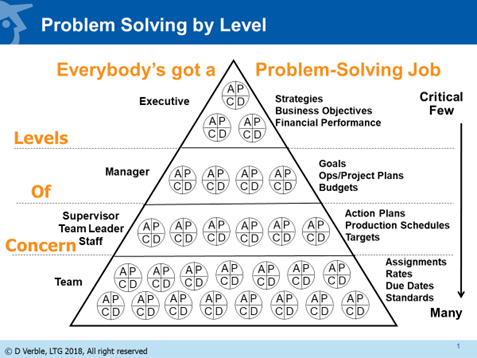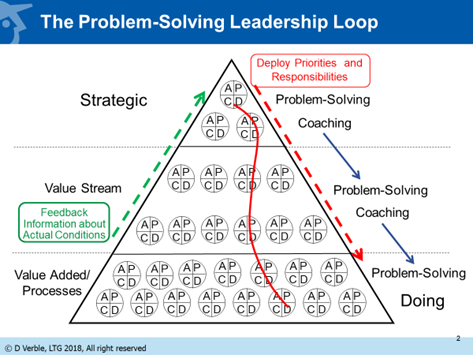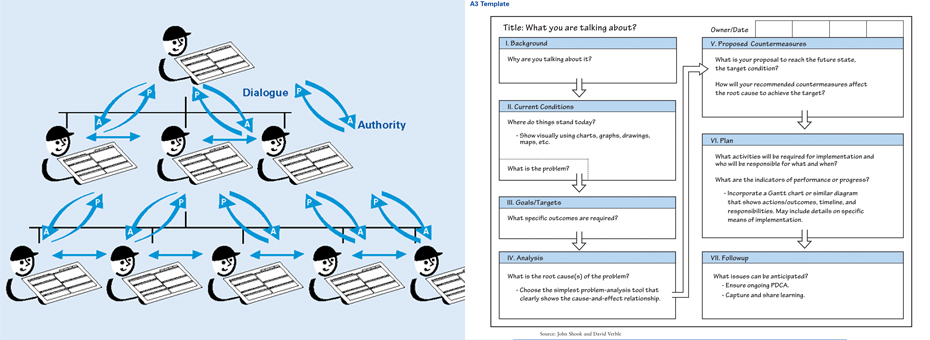During a recent virtual workshop on how to use the A3 problem-solving methodology, R&D/Leverage CEO Mike Stiles asked how to cascade A3s down through every level of the company to link specific initiatives and strategic goals.
The A3 methodology and its associated report capture a problem, analysis, corrective actions, and action plan on a single sheet of paper, usually with ample supporting graphics. Built on the scientific process of plan-do-check-act, the A3 methodology becomes a way of thinking, managing, communicating, learning, completing tasks, and developing an organization of problem solvers. The report typically is done on A3-sized paper, the international term for paper roughly equivalent to U.S. 11-by-17-inch sheets.
Below is the answer from workshop instructor David Verble, a leadership coach at the nonprofit Lean Enterprise Institute, during a follow-up conversation with Stiles and Dave Taylor, R&D/Leverage’s vice president of organizational development. The text was edited for length and clarity.
David Verble: Cascading A3s are used to execute strategy and manage complex projects. The process is built not only around deployment of goals but also deployment of responsibility to think.
The CEO or management committee devising strategy starts the process by doing an A3 that sets the context, describes the strategic priorities, makes their purpose clear, and identifies what is required from each function to execute the strategy. Responsibility is then deployed to the heads of those functions for achieving certain improvements in performance by developing the needed capability. You want results, but in the process of getting them you want to build and maintain the capability to get those results consistently, whether it’s process capability, technical capability, people capability, — or often all three. The deployment responsibility part is the responsibility to think. It’s not just, “I’m giving you a KPI [key performance indicator] to meet, and I want you to do X to help achieve it.”
The person getting the responsibility does an A3 describing their thinking about what has to be achieved, what is the current state and performance capability — demonstrated by reflection on recent results — of the department, unit, or function. In classic problem-solving thinking it presents where do we need to be, what’s the gap in capability, what do we need to develop and change to reach the new level? That A3 sets the context for the staff or lower-level managers and deploys responsibility to them to do similar A3s. Built into this process is a regular schedule of plan-versus-actual reviews that roll up to the levels above and report what’s being accomplished toward the overall strategy, how it’s being done, and what problems, if any, have been encountered.
There is a vertical alignment around critical improvements needed that go down through the organization and a clear picture of what it’s going to take to achieve them comes back up.
In traditional planning, we tend to hand out a lot of KPIs — the new term for goals and objectives – that are often the same for everyone. In strategy deployment, the focus is on two, maybe three critical breakthrough goals, strategic priorities that go beyond current performance. We want to focus on achieving those critical few improvements and hold performance in all other areas constant, so we don’t lose any ground.
Dave Taylor: I like the terminology you’re using about deployment of responsibility. We’re still at that very top level of strategy planning but at some point, as we start deploying strategies down, responsibilities from others must come into play. I’ve been trying to make sure that Mike and the management team understand that Mike’s not going to do all the work for the strategies he’s sponsoring. He’s going to have a lot of help.
David: As the CEO developing the strategy for the business, Mike has responsibility to make sure that everybody understands what he’s trying to accomplish and why he’s trying to accomplish it. That’s part of his A3 strategy report. And he has the responsibility to make sure the people he’s deploying goals to understand what they’re responsible for, why they’re responsible, and what improvements in performance and capability they’re expected to deliver. But his responsibility doesn’t end with deploying down in the organization.
Let’s say Mike has done his A3 and he has assigned a functional manager a goal that is part of his strategy. That manager does an A3 breaking down the goal to outcomes that people at the next level, generally the operational level, are responsible for achieving. Then they do A3s and come back one at a time for back-and-forth discussions for the means they propose to achieve their goals. This process is called “catchball.”
So, Mike might say, “Dave, I think there are several new things your folks will have to learn how to do to achieve the goals you’re deploying.” And then you might respond, “Well, that’s taking on a lot, Mike.” And Mike says, “I know, but the strategy is critical for the success of the business. So, let’s talk about how we can get it done and the support needed. Maybe we can’t get everything done all at once, but we need to improve performance in this area as much as possible.”
So there is a vertical alignment around critical improvements needed that go down through the organization and a clear picture of what it’s going to take to achieve them comes back up. In that process, Mike also is responsible for coaching you, Dave. This should occur regularly but certainly at least quarterly and at mid-year and year-end when the two of you will reflect on what you accomplished, what you learned, and what you need.
When it comes time for your performance review, there aren’t a lot of questions about what got done. Mike knows and you know. And Mike understands if you ran into unanticipated challenges. Sometimes, there will be leftover targets that are carried into the next year and new plans made. Mike also has responsibility for assuring that the managers who are reporting to him are coordinating their efforts horizontally and supporting each other where needed. The result of cascading responsibility through A3s is that Mike has a portfolio of A3s and a clear picture of how he needs to lead and manage to achieve his strategic priorities.
Mike Stiles: The “deployment of responsibility” PowerPoint visuals you sent me made a lot of sense and I forwarded them to Dave. There is one big A3 at the top of the pyramid that is the ultimate goal we’re going for, and then everything below it is all the pieces it takes to put together that strategy to get to that goal. It was a good visual. (See graphics below.)


Dave: I think we’re in the same mindset. We just haven’t done the A3s moving down from the top-level strategy.
David: And as we discussed, it’s not enough, Mike, for you to deploy KPIs for increasing production by say, 4%. You must point out the strategic priority for the increase, why it is critical to the business, what you see as the current capability, what performance level will have to be reached and sustained to achieve the 4%, and what are the gaps in the current capability that will have to be closed?
Maybe production is being dragged down by high scrap. So, you have quality working on it, operations working on it, and you may have engineering working on it. Each department has a piece. Each of them is responsible for delivering their piece, but in coordination with other managers. And as owner of the strategy, Mike, you are responsible for assuring all that happens.
The good thing about the A3 strategy document is that you have the master schedule section that everybody can look at to know how and what they need to contribute to the overall effort and what they each are responsible for achieving by the means they have proposed. It is a major communication tool and its greatest value is that it is based on the plan-do-check-adjust cycle of problem-solving and management. Vertical and horizontal alignment of aims and efforts are achieved through the cascade of A3s that require thinking as well as doing.
Managing to Learn with the A3 Process
Learn how to solve problems and develop problem solvers.






